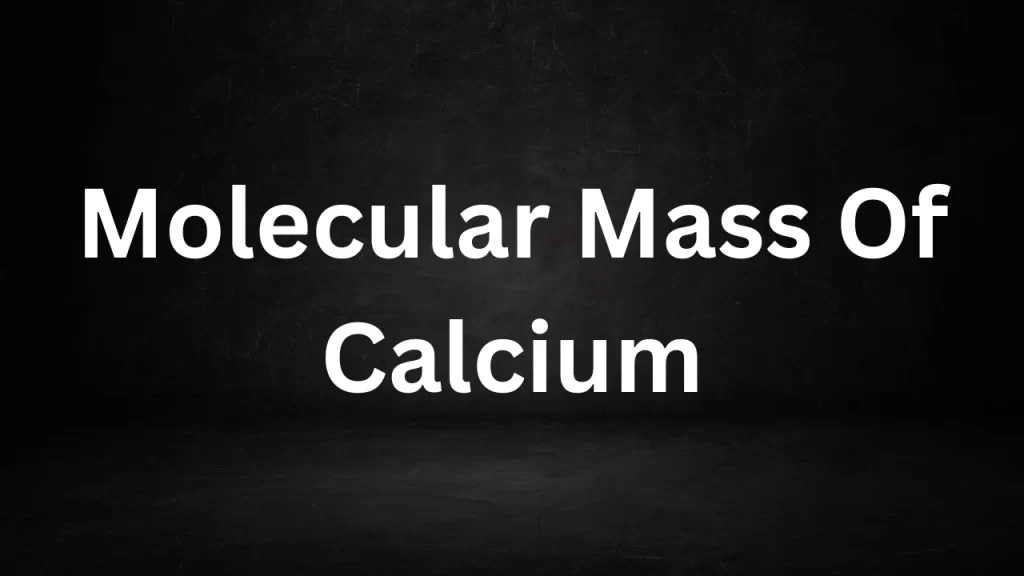Tag: cacl2 2h20 molecular weight
Molecular Weight Of CaCl2
Molecular Weight Of CaCl2: Calcium chloride, often encountered in various industrial, scientific, and everyday applications, is a compound of significant importance.
Comprehending the molecular weight of calcium chloride (CaCl2) serves as a foundational concept in chemistry and various disciplines. In this article, we will explore the concept of calculating the molecular weight of calcium chloride and its significance across different domains.

Molecular Weight Of CaCl2
The Composition of Calcium Chloride:
Calcium chloride, denoted as CaCl2, constitutes a chemical compound consisting of calcium (Ca) and chlorine (Cl) atoms. This hygroscopic salt finds diverse applications, from de-icing roads during winter to industrial processes and laboratory uses.
Calculating the Molecular Weight of Calcium Chloride:
The molecular weight of a substance, also referred to as molar mass, is the mass of one mole of that substance, typically expressed in grams per mole (g/mol). To determine the molecular weight of calcium chloride (CaCl2), we take into account the atomic masses of its constituent elements: calcium (Ca) and chlorine (Cl).
- The atomic mass of calcium (Ca) is approximately 40.08 g/mol.
- The atomic mass of chlorine (Cl) is approximately 35.45 g/mol.
To find the molecular weight of calcium chloride (CaCl2), we sum the atomic masses of one calcium atom and two chlorine atoms:
Molecular Weight of Calcium Chloride (CaCl2) (g/mol) = (1 × Atomic Mass of Calcium) + (2 × Atomic Mass of Chlorine)
Molecular Weight of Calcium Chloride ≈ (1 × 40.08 g/mol) + (2 × 35.45 g/mol) ≈ 110.98 g/mol
So, the molecular weight of calcium chloride (CaCl2) is approximately 110.98 g/mol.
Significance of Molecular Weight in Chemistry:
- Stoichiometry: Molecular weight plays a pivotal role in stoichiometry, aiding in determining the quantities of reactants and products in chemical reactions.
- Molarity: Within the realm of chemistry, molarity (M) serves as a concentration measure, expressed as moles per liter (mol/L). The calculation of molarity in solutions relies on the molecular weight of the solute.
- Chemical Equations: Molecular weight is essential for balancing chemical equations, ensuring the conservation of mass.
Practical Applications:
- De-Icing and Snow Removal: Calcium chloride finds extensive application in de-icing roads and sidewalks in winter because of its capability to reduce the freezing point of water.
- Dust Control: It is utilized to manage dust on unpaved roads and construction sites.
- Concrete Acceleration: Calcium chloride accelerates the setting of concrete, making it a valuable construction material.
Conclusion:
The molecular weight of calcium chloride (CaCl2), approximately 110.98 g/mol, is a fundamental concept in chemistry with extensive applications in various industries. It is a key factor in stoichiometry, molarity calculations, and chemical equation balancing. Calcium chloride’s versatile uses, influenced by its molecular weight, encompass de-icing, dust control, and concrete acceleration, highlighting the profound impact of chemistry on our daily lives and industrial processes.
Read More
- Molecular Weight Of Copper
- Molecular Mass Of Ethanol
- Molecular Mass of Ammonia
- Molecular Weight of H2O
- Molar Mass Of Sugar
Frequently Asked Questions (FAQs) Molecular Weight Of CaCl2
Q1: What is the molecular weight of calcium chloride (CaCl2)?
A1: The molecular weight of calcium chloride (CaCl2) is approximately 110.98 grams per mole (g/mol). This value is calculated based on the atomic masses of its constituent elements: calcium (Ca) and chlorine (Cl).
Q2: Why is the molecular weight of calcium chloride important in chemistry?
A2: Understanding the molecular weight of calcium chloride is crucial in chemistry because it is used in stoichiometry to determine reactant and product quantities, in molarity calculations for solutions containing calcium chloride, and in balancing chemical equations.
Q3: Can the molecular weight of calcium chloride change under different conditions?
A3: No, the molecular weight of calcium chloride remains constant regardless of temperature, pressure, or other conditions. It is a fixed value based on the atomic masses of calcium and chlorine.
Q4: What are the practical applications of calcium chloride related to its molecular weight?
A4: Calcium chloride has practical applications in de-icing roads, controlling dust on unpaved surfaces, accelerating concrete setting, and as a drying agent in various industries. Its molecular weight is relevant in determining the amount of calcium chloride used in these applications.
Q5: Is calcium chloride safe for use in food and pharmaceuticals?
A5: Calcium chloride is generally recognized as safe (GRAS) when used as a food additive and is used in food preservation, cheese making, and as a firming agent. In pharmaceuticals, it has specific uses and is regulated for safety.
Molecular Mass Of Calcium
Mol Mass Of Calcium: Calcium, with its symbol Ca and atomic number 20, is a fundamental element in the periodic table. It is renowned for its crucial role in biological processes, as well as its various applications in industry, agriculture, and everyday life.
Understanding the mol mass of calcium is essential for comprehending its behavior and significance in the world of chemistry. In this article, we delve into the concept of molecular mass, its calculation for calcium, and the implications of this fundamental property.

Mol Mass Of Calcium
The Nature of Calcium
Calcium is a metallic element found in group 2 (formerly group IIA) of the periodic table, along with other alkaline earth metals. It is a silvery-white, soft metal that reacts vigorously with water and oxygen, forming compounds like calcium oxide (CaO) and calcium hydroxide (Ca(OH)2). In its natural state, calcium is often found in the form of calcium carbonate (CaCO3), which makes up materials like limestone, chalk, and shells.
Importance of Molecular Mass
Mol mass, also known as molar mass or molecular weight, is the mass of a molecule or compound expressed in atomic mass units (amu) or grams per mole (g/mol). It is a fundamental concept in chemistry and has several key implications:
- Stoichiometry: Molecular mass is crucial for calculating the molar ratio of reactants and products in chemical reactions, aiding in the determination of reaction yields and limiting reagents.
- Synthesis and Formulation: Chemists use molecular mass to precisely measure and combine reactants when synthesizing compounds or formulating chemical solutions.
- Analytical Chemistry: Molecular mass is essential in the identification and quantification of compounds using techniques like mass spectrometry.
- Physical Properties: Molecular mass influences a compound’s physical properties, including melting and boiling points, density, and solubility.
Calculating the Molecular Mass of Calcium
To calculate the molecular mass of calcium (Ca), you consider the atomic mass of a single calcium atom. The atomic mass of calcium is approximately 40.08 atomic mass units (amu).
Now, let’s calculate the molecular mass of calcium (Ca):
Molecular Mass of Calcium (Ca) = Atomic Mass of Calcium Molecular Mass of Calcium (Ca) = 40.08 amu
The molecular mass of calcium is approximately 40.08 amu.
Implications of Calcium’s Molecular Mass
The molecular mass of calcium, approximately 40.08 amu, has several implications in the field of chemistry and various applications:
- Quantitative Analysis: In analytical chemistry, calcium’s molecular mass is essential for accurately determining its concentration in samples, such as in water quality testing.
- Chemical Reactions: Calcium’s molecular mass plays a key role in stoichiometric calculations for chemical reactions involving calcium compounds, ensuring precise measurements and predictions.
- Biological Role: In biology, calcium ions (Ca2+) are vital for numerous physiological processes, including muscle contraction, nerve signaling, and blood clotting.
- Industrial Applications: Calcium and its compounds are used in diverse industrial applications, including the production of steel, cement, and fertilizers, as well as in the food and pharmaceutical industries.
Conclusion
The molecular mass of calcium, approximately 40.08 amu, is a fundamental property that plays a pivotal role in chemistry and various scientific disciplines. It is indispensable for stoichiometric calculations, accurate measurements, and an in-depth understanding of calcium’s chemical and physical properties. As a versatile element with significant applications in industry, agriculture, and biology, calcium’s molecular mass continues to be a critical parameter for researchers and professionals working with this essential element.
Read More
- Molecular Weight Of Sucrose
- Molecular Mass Of Carbon
- Molar Mass Of Phosphorus
- Molar Mass of Chlorine
- Electrical Energy And Power
Frequently Asked Questions (FAQs) Molecular Mass Of Calcium
Q1: What is molecular mass or molecular weight?
A1: Molecular mass, also known as molar mass or molecular weight, is the mass of a molecule or compound expressed in atomic mass units (amu) or grams per mole (g/mol). It is a fundamental property used in chemistry to quantify the mass of chemical substances.
Q2: What is the chemical symbol for calcium?
A2: The chemical symbol for calcium is Ca.
Q3: Is calcium a metal or non-metal?
A3: Calcium is a metal. It belongs to the group of metals known as alkaline earth metals.
Q4: Why is calcium important in biology?
A4: Calcium plays a crucial role in biology as a key intracellular signaling ion. It is involved in various physiological processes, including muscle contraction, nerve transmission, blood clotting, and cell communication.
Q5: How is the molecular mass of calcium calculated?
A5: To calculate the molecular mass of calcium (Ca), you consider the atomic mass of a single calcium atom, which is approximately 40.08 atomic mass units (amu).